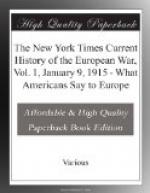The first paper contains a letter to the British Ambassador in Berlin concerning the Austro-Servian relations. Is it not probable that Sir Edward Grey’s attention was called to this question by his Ambassador in Vienna? Where is his letter? Or, if Sir Edward thought of it himself, why did he not mention his conversation also to Sir M. de Bunsen in Vienna? Where is this note? Are we to assume that Sir M. de Bunsen made his first report on July 23, although Sir Edward Goschen in Berlin had an interesting report to make a day earlier?
We can thus go through the whole British “White Paper” and discover the omission of many interesting documents.
No. 38 is a letter from Sir Rennell Rodd in Rome, dated on July 23 and received on July 27. He had no doubt sent also a telegram. What did it contain, and why was it not published under the date of its arrival instead of the letter which had been delayed in transit?
Where Is No. 28?
In No. 29 Sir Edward Grey refers in a telegram to Sir R. Rodd to what “I had said to the German Ambassador.” Such a reference could have a meaning for Sir R. Rodd only if he had been informed of this conversation. There is no dispatch printed in the “White Paper” containing this information. Possibly it was so entwined with other instructions, which Sir Edward Grey did not care to have known, that it could not be published. Was it perhaps sent to the printer first as No. 28, and removed at the last moment when it was too late to change the subsequent numbers? Or, if this assumption is wrong, what was printed originally as No. 28? Where is No. 28? There are other omissions, and one especially noteworthy one between Nos. 80 and 106 which will be discussed later.
Viewed in this light, the English “White Paper” loses much of the value of a complete record, which it has had in the eyes of many. There is absolutely no reason to doubt the accuracy of those dispatches which have been printed, but it becomes incumbent upon the searcher after the truth to inquire whether the existence of unprinted (in the case of the German “White Paper” Mr. Beck uses the term “suppressed”) papers may not at times alter the interpretation which should be given to those that are printed.
Since we have no published records anywhere concerning the advice given to Italy by the Allies, and the gradual steps leading up to Italy’s decision to remain neutral; nor any hint as to the day when her decision was communicated to England and the other powers, it would be futile to speculate on this subject. Since, however, the Queen of Italy and the wife of the Commander in Chief of the Russian forces are sisters, and since it was in the interest of the Allies to keep Italy neutral, it is not unreasonable to assume that an exchange of opinion took place between Italy and the Allies concerning the conditions under which Italy would remain neutral.
If the actual opening of hostilities could be so managed that Germany could be called the aggressor, then Italy probably declared that she would not enter the war. This is a very important phase of the case, and the omission from Sir Edward Grey’s “White Paper” of all dispatches dealing with Italian neutrality is much to be regretted.




